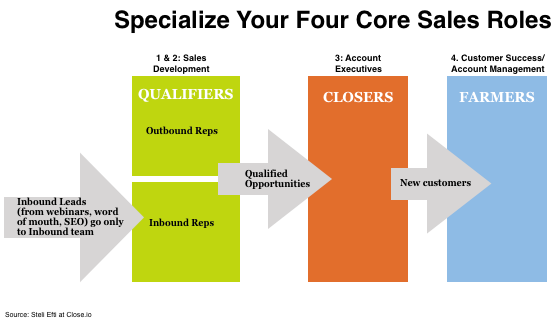Effective Sales Organization Structures
In nearly every industry and particularly those in B2B markets, the sales organization is the lifeblood of a company’s growth. While these teams are universally tasked with the same goal, namely creating revenue from new accounts and driving incremental sales from existing accounts, we have seen sales organizations structured in many ways, with varying results. Often, these teams are overly reliant on a handful of superstar salespeople and lack the leadership, organization, tools, and accountability necessary to grow to the next level.
Sales organizations that are truly effective grow and evolve over time, often through four phases of evolution:
- Hunter Founder
- One-Man Bands
- Specialists
- Market Teams
Hunter Founder
In the early stages of a company’s development, sales organizations are often composed of the company’s founder or a single sales leader driving the company’s growth. Given the dual role, sales processes and tools are limited or nonexistent. Sales efforts rely on the personal connections and outreach of the founder or single sales leader. Inbound efforts and account management may be performed as part of the service and support organization’s responsibilities, and concerted sales efforts are often a secondary concern at this point.
One-Man Bands
In the next stage of a company’s development, sales organizations comprise a collection of one-man bands, typically reporting to a VP of Sales. Each of these salespeople are responsible for prospecting, qualifying, and closing new business. They are often assigned a specific geographic territory and given quotas as annual sales goals. A variety of activities, including new customer calls, meetings, proposals, and closings, are measured and tracked against targets as each salesperson drives towards their individual quotas.
While this structure can be effective for a period, the One-Man Band model, which relies on individuals to perform the full spectrum of sales tasks, lacks the scalability and efficiency necessary to drive significant long-term growth.
Specialists
Phase 3 sales organizations morph from a collection of individual utility players to a system of specialists focused on one of the four fundamental aspects of the sales conversion process.
- Sales Development – Outbound: These sales reps are the hunters that focus on prospecting and qualifying new leads, which are then handed off to the Account Executives. Often termed Outside Sales, these professionals are in the field, networking and uncovering new potential opportunities.
- Sales Development – Inbound: A second group of sales reps handle inbound, warm leads that come from the company’s advertising, marketing, and other lead generation efforts, including webinars, word of mouth, and online SEO. All inbound leads are routed to this team, and then qualified leads are passed to Account Executives.
- Closing the Deal: Account Executives receive qualified leads from the sales development team and focus their time and energy on closing the sale. Typically, these are the company’s more senior and experienced sales professionals.
- Ongoing Account Management: Newly converted customers are transitioned to a customer success account manager, who serves as an ongoing point of contact, handles documentation and any other onboarding, and is responsible for ongoing customer success and mining follow-on opportunities.
Market Teams
The fourth phase of sales organizational structure builds on the specialist framework, creating multiple teams focused on particular target market segments, product lines, or geographies. Each of these teams comprises a combination of specialists, so that the full spectrum of the sales conversion process occurs within each group. The composition of the four types of specialists within each team may vary depending on the nature of the sales process within a given market. As an example, one team may have an extra Inbound Sales Development Rep to handle higher volumes of incoming prospects, while another may have an extra Account Executive if their closing process is more time-intensive.
Leadership and Process Discipline
No matter which sales organization structure your company implements, effective sales leadership is critical. The best sales leaders create a culture of discipline, accountability, and transparency that permeates the sales team and focuses on key activities known to support the company’s strategic growth initiatives. Activity tracking, weekly sales team calls, rigorous pipeline reporting, and targeted compensation are key tools effective sales leaders use to manage their teams and report out to the company’s executives.
About the Author
Jonathan Brabrand is a Managing Director at Fahrenheit Advisors. His passionate about helping businesses prosper and maximize value to their employees, customers, communities, and owners. Instilled with a spirit of entrepreneurism from a young age, Jonathan draws on his experience as a business owner, trusted strategic advisor, and investment banker to identify and overcome the challenges clients face. Learn more about Jonathan Brabrand.
Editor’s note: Fahrenheit Advisors is a trusted Sponsor of VA Council of CEOs. This article was originally posted to FahrehenheitAdvisors.com.




Leave a Reply